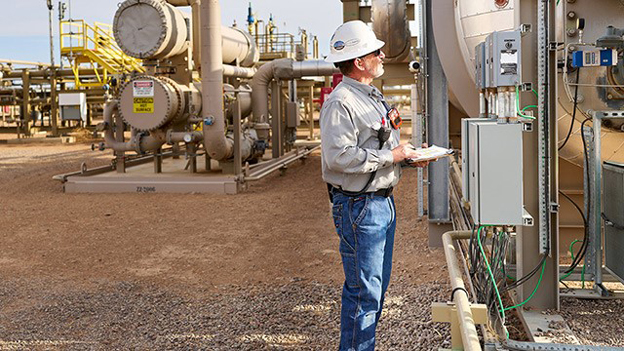
Inspecting instruments at a central gathering facility near Pecos, Texas, in the Permian Basin. Image source: Chevron
The Permian Basin is an energy-rich depression in the earth’s crust that spans parts of West Texas and New Mexico. How rich? It accounts for nearly 40% of the oil production and 15% of the natural gas production in the United States.
At approximately 250 miles wide and 300 miles long, this shale basin is larger than the entire state of Florida. Chevron, one of the largest oil and gas producers in the region, owns approximately 2.2 million net acres in the region.
Geology
Unique rock characteristics make the Permian Basin one of the most prolific fields in the world.
Its geology enables a single well to produce oil and natural gas from several layers of rock in different geological zones. This multiplies the basin’s natural resource potential.
The Permian Basin is the second-largest shale gas producing region in the US. Natural gas production there reached a record high of 16.7 billion cubic feet per day in 2021.
Technology’s role
Advances in hydraulic fracturing and horizontal drilling technologies have accelerated production in the Permian Basin. The number of horizontal wells in the region grew from 350 in 2010 to 4,524 in 2021.
Chevron is tapping into high tech to drill more efficiently in the Permian Basin by using:
- Advanced technologies to boost well performance.
- Predictive analytics to make decisions related to exploration strategy, resource characterization, drilling and the final stages of well construction.
Because of the Permian Basin, Texas not only receives an enormous economic benefit but also helps provide energy security for the country. The greater Permian Basin accounts for nearly 40 percent of all oil production in the United States and nearly 15 percent of its natural gas production, according to the Federal Reserve Bank of Dallas. And there’s significant potential growth simply from the Delaware Basin. In 2018, the U.S. Geological Survey estimated that the Delaware Basin in West Texas and Southern New Mexico has the potential to produce 46.3 billion barrels of oil and the potential to produce 281 trillion cubic feet of natural gas.
Chevron plan to increase production there to 1 million barrels of oil-equivalent per day by 2025 and believe technology will help get us there.
KeyFacts Energy Chevron US Gulf of Mexico country profile
 KEYFACT Energy
KEYFACT Energy